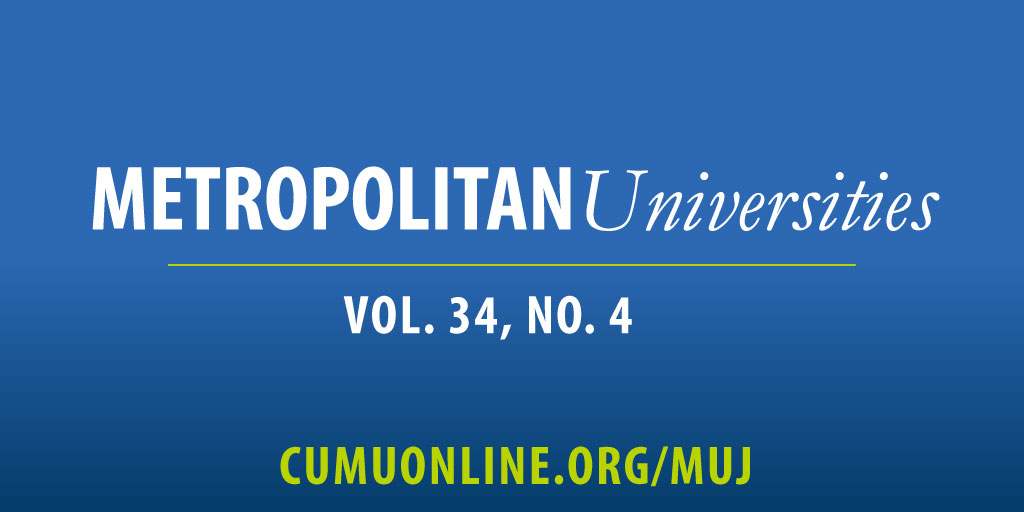Championing Social Mobility
DOI:
https://doi.org/10.18060/27325Abstract
When I became president of California State University San Marcos (CSUSM) during the summer of 2019, I was excited to launch a listening and learning tour to get to know the campus community, which includes just over 16,000 students and nearly 60,000 alumni. As a former vice president for Student Engagement and Enrollment Services at Old Dominion University (ODU), I was drawn to CSUSM because of its diverse and multicultural community as well as its established track record of student success. I was eager to meet our students and hear their stories – why did they choose CSUSM? What has their educational journey been like? What are their hopes and dreams for the future?
Of course, no two students provided the same answer. Some told me about the pride of being first in their families to go to college but the uncertainty that went along with that as they navigated the financial aid and admissions applications without parental support. Others told me about the challenges of going to school while juggling part-time or full-time jobs and/or parenting responsibilities. And still, others shared stories from their previous military experience or their desire to make a career change/enhance their career trajectory. While almost universally, our students share their excitement to make progress toward their degrees, many also imparted complex combinations of family responsibilities, employment, and financial pressures which required constant time and energy to navigate.
As leaders in CUMU institutions, you know these stories – the individual details are different, but themes of students striving to overcome financial, geographic, and socioeconomic challenges are surely familiar. Institutions like ours proudly embrace our regional role to serve as strongholds of the American Dream, serving an outsized share of historically underserved populations (such as low-income, minority and first-generation students) and offering programs and services that meet them where they are, fitting into the reality of their lives with opportunities to engage in real-world learning that will launch them into meaningful careers and a lifetime of success.
Now, as we emerge from the depths of the COVID-19 pandemic - the effects of which we will surely feel for years to come – coupled with rising income inequality and economic recession, our role as elevators of social mobility for the students and communities we serve is more important than ever.
But what is social mobility? When I began sponsoring conversations on this topic at my former institution, where I co-founded a National Center on Social Mobility, I noted that there was not always a clear understanding of the definition. At its core, social mobility is the movement of individuals from one socioeconomic status to another, and higher education is one of the most important drivers of an individual’s upward mobility in society. At CSUSM, we recognize that the education we provide helps our students transcend barriers faced by earlier generations, unlocking their potential for lifelong success. This isn’t only key for individuals and families but organizations, industries and society which benefit from a broadened talent pipeline, innovation, greater social equity and economic mobility across all sectors.
However, historically, higher education in the United States has contributed to the socioeconomic divide rather than solved it. National college rankings have exasperated the situation further, lauding exclusivity in admissions rather than scrutinizing the ways colleges actually create broad access. While organizations like CollegeNet have published a Social Mobility Index (on which CSUSM was proud to rank No. 1 in fall 2022) for about a decade, it was only in 2018 that US News added a social mobility factor its rankings – a direct outcome of those early conversations I just mentioned. Another exciting and promising marker – a new Carnegie classification will measure how institutions contribute to social and economic mobility while serving a diverse student population.
Today, I am so proud to be a part of CUMU, an organization that recognizes not only that “Place Does Matter” but that we are uniquely positioned to impact social mobility and inclusive regional growth – economic growth that is distributed fairly across society and creates opportunities for all. Collectively, we represent over 52 metropolitan areas; and 33% of our institutions are designated minority serving institutions. At CSUSM, 55% of our students are first generation, about 50% are Hispanic/Latin-x, 40% are 23 years or older, 40% are Pell-eligible, and over 10% are veterans or military affiliated. Because of all these factors, the majority of our students are considered “nontraditional” – although I would argue that nontraditional IS the new tradition.
As we look to the immediate future, as leaders and practitioners in our respective organizations, it’s an economic and social imperative that we develop and share new strategies which can fuel social mobility and inclusive regional growth. Providing access in an affordable way, broadening the educational pipeline, committing to student success, and graduating students into high-quality jobs will have a transformational ripple effect in our communities. Individually and collectively, we can leverage these practices to support our students and communities by:
- Promoting Integrative & Hands On-Learning
- Expanding Access & Prioritizing Student Success
- Eliminating Barriers and Advocating for Affordability
Downloads
Published
Issue
Section
License
Copyright (c) 2023 Ellen Neufeldt

This work is licensed under a Creative Commons Attribution 4.0 International License.



